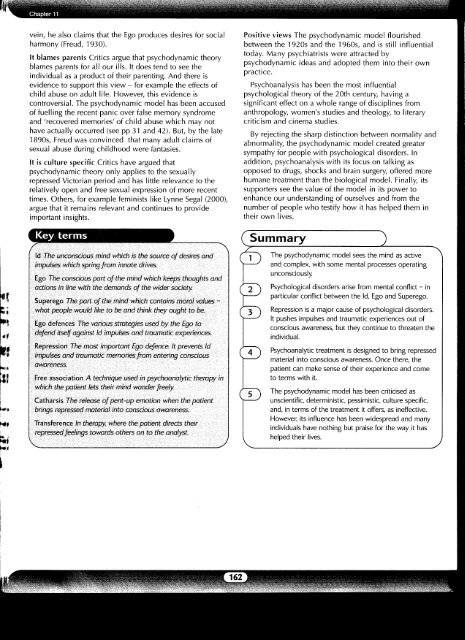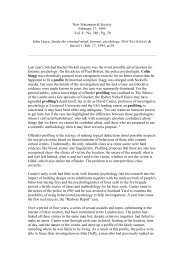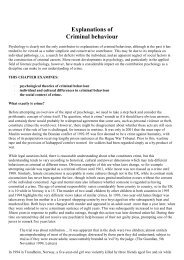Ch 11 - Jeff Standen
Ch 11 - Jeff Standen
Ch 11 - Jeff Standen
Create successful ePaper yourself
Turn your PDF publications into a flip-book with our unique Google optimized e-Paper software.
vein, he also claims that the Ego produces desires for social<br />
harmony (Freud, 1930).<br />
It blames parents Critics argue that psychodynamic theory<br />
blames parents for all our ills. It does tend to see the<br />
individual as a product of their parenting. And there is<br />
evidence to support this view - for example the effects of<br />
child abuse on adult life. However, this evidence is<br />
controversial. The psychodynamic model has been accused<br />
of fuelling the recent panic over false memory syndrome<br />
and 'recovered memories' of child abuse which may not<br />
have actually occurred (see pp 31 and 42). But, by the late<br />
1890s, Freud was convinced that many adult claims of<br />
sexual abuse during childhood were fantasies.<br />
It is culture specific Critics have argued that<br />
psychodynamic theory only applies to the sexually<br />
repressed Victorian period and has little relevance to the<br />
relatively open and free sexual expression of more recent<br />
times. Others, for example feminists like Lynne Segal (2000),<br />
argue that it remains relevant and continues to provide<br />
important insights.<br />
Key terms<br />
r.<br />
Id The unconscious mind which is the source of desires and<br />
V<br />
impulses which spring from innate<br />
drives.<br />
Ego The conscious part of the mind which keeps thoughts<br />
actions in line with the demands of the wider<br />
society.<br />
Superego The part of the mind which contains moral values -<br />
what people would like to be and think they ought to be.<br />
Ego defences The various strategies<br />
defend itself against Id impulses and traumatic<br />
used by the Ego to<br />
experiences.<br />
Repression The most important Ego defence. It prevents<br />
impulses and traumatic memories from entering<br />
awareness.<br />
Free association A technique used in psychoanalytic<br />
which the patient lets their mind wander<br />
freely.<br />
Id<br />
conscious<br />
and<br />
therapy in<br />
Catharsis The release of pent-up emotion when the patient<br />
brings repressed material into conscious awareness.<br />
Transference In therapy, where the patient directs<br />
repressed feelings towards others on to the analyst.<br />
their<br />
'<br />
Positive views The psychodynamic model flourished<br />
between the 1920s and the 1960s, and is still influential<br />
today. Many psychiatrists were attracted by<br />
psychodynamic ideas and adopted them into their own<br />
practice.<br />
Psychoanalysis has been the most influential<br />
psychological theory of the 20th century, having a<br />
significant effect on a whole range of disciplines from<br />
anthropology, women's studies and theology, to literary<br />
criticism and cinema studies.<br />
By rejecting the sharp distinction between normality and<br />
abnormality, the psychodynamic model created greater<br />
sympathy for people with psychological disorders. In<br />
addition, psychoanalysis with its focus on talking as<br />
opposed to drugs, shocks and brain surgery, offered more<br />
humane treatment than the biological model. Finally, its<br />
supporters see the value of the model in its power to<br />
enhance our understanding of ourselves and from the<br />
number of people who testify how it has helped them in<br />
their own lives.<br />
( Summary<br />
1<br />
1 \e psychodynamic model sees the mind as active<br />
and complex, with some mental processes operating<br />
unconsciously.<br />
Psychological disorders arise from mental conflict - in<br />
particular conflict between the Id, Ego and Superego.<br />
Repression is a major cause of psychological disorders.<br />
It pushes impulses and traumatic experiences out of<br />
conscious awareness, but they continue to threaten the<br />
individual.<br />
Psychoanalytic treatment is designed to bring repressed<br />
material into conscious awareness. Once there, the<br />
patient can make sense of their experience and come<br />
to terms with it.<br />
The psychodynamic model has been criticised as<br />
unscientific, deterministic, pessimistic, culture specific,<br />
and, in terms of the treatment it offers, as ineffective.<br />
However, its influence has been widespread and many<br />
individuals have nothing but praise for the way it has<br />
helped their lives.







